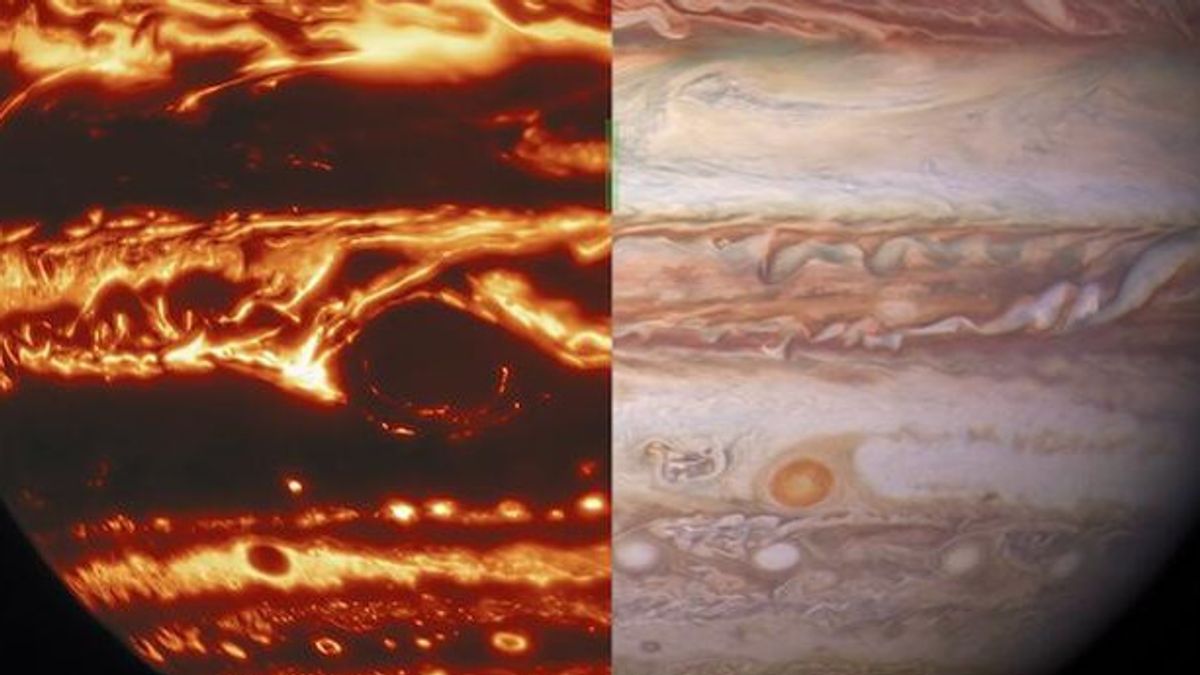JAKARTA - NASA's Juno mission has unearthed terrifying new details about Jupiter's Great Red Spot region. They reveal that the massive vortex cloud is actually about 300-500 kilometers deep and has shed more light on its structure as well.
The Great Red Spot - one of the most distinctive features of the planet - is actually a massive storm in which the clouds rotate counterclockwise at a very high speed of about 400 miles per hour and have shading between dark red and dark orange.
The 'Anticyclone' is roughly 1.3 times wider than Earth's diameter and is said to have been circling Jupiter's sky for a while. Jupiter has abundant Hydrogen and Helium, but so far, scientists have been unable to pinpoint the reason behind the storm's brilliant red color.
One theory is that cosmic rays might chemically change the ammonium hydrosulfide in its atmosphere to produce new compounds that give it a different color. However, images captured by the Hubble telescope recently revealed that the Great Red Spot storm is accelerating.
#JunoMission lends deeper understanding of what is happening below Jupiter’s cloud cover. The team’s findings highlight the inner workings of the gas giant's belts and zones, polar cyclones and even the Great Red Spot. https://t.co/OSvhicCZ4b pic.twitter.com/ASFiaQXjj7
— NASA JPL (@NASAJPL) October 28, 2021
Now, new findings emerging from data collected by the Juno probe have revealed that cyclones on Jupiter are warmer at the top and have a lower atmospheric density.
At the same time, the cooler areas below indicate a higher atmospheric density. However, anticyclones like the Great Red Spot - believed to be one of the planet's longest-lived eddies - are warmer at the bottom and colder at the top.
More importantly, the data reveals that the Great Red Spot is much deeper than previously thought as it stretches between 300 to 500 kilometers (or 186 to 310 miles deep) beneath the clouds. Interestingly, just a few months ago, NASA spotted signs of water on Jupiter's moon Ganymede.
If Placed On Earth, Hurricane Will Hit The Space Station
While flying over the Great Red Spot, the Juno spacecraft measured the gravitational field in the region to estimate the depth of the storm. These readings helped scientists calculate the maximum depth of the anticyclone.
SEE ALSO:
The team then used readings taken by the Microwave Radiometer (MWR) instrument aboard the spacecraft to measure the planet's emitting flux at different depths, ranging from the top of the atmosphere to 600 kilometers below visible clouds.
Jupiter's atmosphere is composed mostly of molecular hydrogen and helium with small amounts of methane, ammonia, and hydrogen sulfide, but its moon Europa is thought to harbor large amounts of ice with water beneath that may harbor some life forms.
The latest findings have also opened a "treasure chest of new information about Jupiter's mysterious observable features," notes Lori Glaze, director of NASA's Division of Planetary Sciences. For the first time, scientists were also able to create detailed 3D maps of Jupiter's hard atmosphere to reveal how the planet's cloud belts and zones function.
To the unconscious, the white and red stripes seen in Jupiter's image are actually bands and zones separated by east-west winds moving in opposite directions. This wind, also known as the Jet Stream, is much deeper than the Great Red Spot.
This jet stream has a depth of about 3,200 kilometers, but researchers are still not clear why there is such a big difference. However, Jupiter is far from the planet with the most extreme atmosphere. A recent study of the planet WASP-76b revealed that temperatures in this "land of hell" exceed 2.400 degrees Celsius, and it's so hot here that clouds rain iron.
The English, Chinese, Japanese, Arabic, and French versions are automatically generated by the AI. So there may still be inaccuracies in translating, please always see Indonesian as our main language. (system supported by DigitalSiber.id)


















